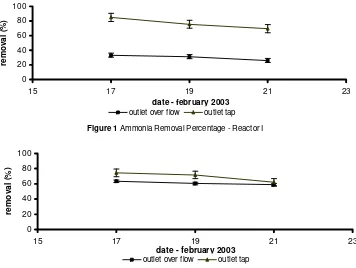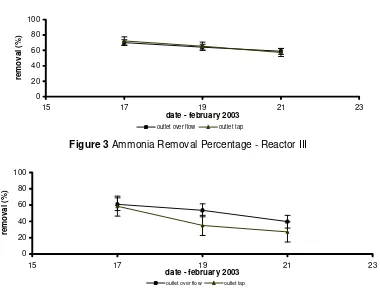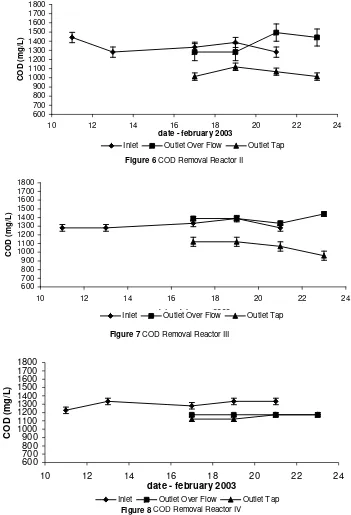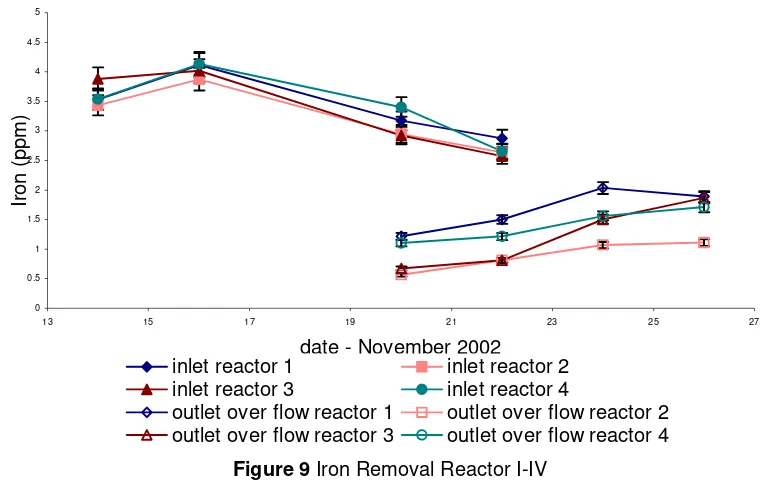THE EFFICIENCY OF CHARCOAL AS A FILTER MEDIA IN NON-VEGETATION
CONSTRUCTED WETLAND SUBSURFACE-FLOW SYSTEM (SF)
FOR AMMONIA, CHEMICAL OXYGEN DEMAND, AND IRON
TREATMENT OF LANDFILL LEACHATES
Ahmad Md. Noor, Pedy Artsanti, P.E.Lim
School of Chemical Sciences Universiti Sains Malaysia, 11800 Penang, Malaysia S. Suryani
School of Distance Education Universiti Sains Malaysia, 11800 Penang, Malaysia H.P.S Abdul Khalil
School of Industrial Technology Universiti Sains Malaysia, 11800 Penang, Malaysia
ABSTRACT
The thermal Charcoal for domestic used was crushed into powder and mixed with gravel. Four reactors of different proportion and size of charcoal and gravel were set up without vegetation. Sample of landfill leachates obtained from site of Pulau Burung Landfill, Penang, was introduced into the reactors. Ammonia, chemical oxygen demand (COD), and iron of inlet and outlet from four reactors were analyzed by standard methods. Result shows that overall performance of removing ammonia and iron were much better than COD.
Keywords:charcoal, leachate, filter media.
INTRODUCTION
Solid wastes are considered of all the wastes arising from human and animal activities that are normally solid and are discarded as useless or unwanted. Solid waste disposal if not properly handle created problems to the country, which will contribute to environmental problems. Although campaign for recycling the solid waste is carried out through out the country, the successful of the process is still very small. The disposal of solid waste mainly by land-filling, ranging from 70-90% of the most industrialized countries to 95-100% in the rest of the world [1]. However, land-filling the solid waste eventually created another problem due to leachtes formation, typically from infiltrating waters and products of solid waste decomposition.
Old and new landfills produce leachates. Those contaminated leachate waters are potential threat to surface and subsurface receiving waters. A very wide spectrum of pollutants is possible, reflecting the character of the materials contained in the stack. The principle categories of undesirable substances are (1) volatile organic compounds, (2) nutrients, notably nitrogen, (3) heavy metals, and (4) priority toxic organic compounds [2]. Constructed wetland treatment of the leachate is one option for water quality improvement.
The propose of this study was to compare the removal efficiencies of charcoal and gravel as filter media in the constructed wetland treatment systems for ammonia, chemical oxygen demand (COD), and
iron and identify the optimal one for leachate treatment.
METHODOLOGY
Four constructed wetland reactors were built with dimension of 29 cm wide, 40 cm long and 35 cm depth. The depth of the filter media for all reactors was the same at 30 cm. The inlet and outlet tap ports were situated approximately halve of the media height while outlet overflow was at the same level of the media surface. The media constitute of gravel, charcoal granule and charcoal powder with diameter size ranges between 2 mm – 5 mm, 2 mm – 5 mm and less than 2 mm, respectively. Prior to apply media samples into reactors, the samples were washed thoroughly first by immersed in hydrochloric acid (1: 9 v/v) for 24 hours, and later washed with tap water until neutral. Composition and capacity of media in reactors, flow rate and hydraulic retention time (HRT) for leachate sample are given in the table 1.
Table 1 Data of the reactor
Reactor I II III IV
Type of media Gravel, 100% Gravel : Charcoal = 2 : 1
Gravel : Charcoal = 2 : 1
Gravel : charcoal = 1 : 1
RESULTS AND DISCUSSION
Ammonia
Results on percentage ammonia removal after treatment with different composition of filter media are given in the Figures 1 – 4. Overall performance were good, especially samples analyzed at outlet tap, which was generally better than the outlet overflow. Reactor I consist only gravel as media managed to remove ammonia 85-69 %, sample was analyzed at outflow tap. Mixing gravel with increasing capacity of charcoal showed decreasing amount of removal efficiency. Present of gravel alone provided high porosity that producing a greater ammonia concentration in the effluent during culturing period [4]. The amounts of
microorganisms growing on the media surface were larger will results the microbial activities would be greater resulting in higher ammonia removal efficiencies occurring in this Reactor I. Granulated charcoal although provide similar porosity and has sorption capacity was shown unable to contribute to better removal efficiency of ammonia. Since the removal mechanisms of nutrients such as nitrogen (N) include uptake by plants and other living organisms, and other process [5], the removal of ammonia in this study will be expected to be much higher. However, according to the study [6] shows that only 4-11 % of nitrogen removed by the planted wetland was due to vegetation uptake, and 89-96 % was due to denitrification.
Figure 1 Ammonia Removal Percentage - Reactor I
0
date - february 2003
removal (%)
outlet over flow outlet tap
Figure 2 Ammonia Removal Percentage - Reactor II
0
date - february 2003
removal (%)
Figure 3 Ammonia Removal Percentage - Reactor III
date - february 2003
remo
val
(%)
outlet over flow outlet tap
Figure 4 Ammonia Removal Percentage - Reactor IV
0
date - february 2003
remo
val
(%)
outlet over flow outlet tap
Chemical oxygen demand (COD)
Results of COD analyzed at three different ports, namely inlet, outlet tap and outlet overflow for a constant days interval are shown in Figures 5-8. No significant different are observed for samples at inlet and outlet overflow except for Reactor IV, which is estimated of about 12 ±1.6 %. Reactor I, which contain only gravel shows the lowest efficiency. The other three reactors, which also
contain some portion of charcoal however provide better performance. The highest performance is observed in Reactor II, which composed of media from gravel with one third of it contains powdered charcoal. In this case it seems that media porosity play a role in the performance of COD removal [7]. The powdered charcoal in Reactor II contributed to less porous to the media, performed the highest efficiency in removing COD.
Figure 5 COD Removal Reactor I
600
date - february 2003
COD (mg
/L
)
Iron
The experiment results for iron removal in the constructed wetland systems without vegetation are shown in Figure 9. The removal process of iron shows good performance for all reactors. Reactor I, which contain only gravel shows the lowest removal percentage, 51.50% in average. The others three reactors, which also contain some
portion of charcoal however provide better treatment efficiency. The highest treatment efficiency is observed in Reactor II, which composed of media from gravel with one third of it contains powdered charcoal. According to Figure 9, Reactor I, III, and IV decrease a significant amount of iron removal percentage at the end of the experiment. Thus, it is inferred that metals are removed by a number of mechanism that all end up with storage in the media
Figure 8 COD Removal Reactor IV
600
date - february 2003
COD (mg/L)
Inlet Outlet Over Flow Outlet Tap
Figure 6 COD Removal Reactor II
600
date - february 2003
COD (mg
/L
)
Inlet Outlet Over Flow Outlet Tap
Figure 7 COD Removal Reactor III
600
date - february 2003
COD (mg
/L
)
[2]. In this case it seems that types of the media play a role [8] in the removal efficiency of iron. The powdered charcoal in Reactor II contributed to increase surface area to the media, performed the highest efficiency in removing iron
Table 1 also shows pH for leachate before and after treatment. The pH of raw lechate is slightly basic but changed considerably to almost neutral after went through the treatment process.
Conclusion
This study has shown that differences in ammonia, COD, and iron removal efficiency are related to type of filter media in the constructed wetland treatment systems. The most efficient treatment of ammonia, COD and iron is in Reactor I and II, respectively.
Acknowledge
This study is supported by IRPA grant 305/PKIMIA/610810, Kementrian Sains, Teknologi dan Alam Sekitar Malaysia. We also wish to thank to the Idaman Bersih Sdn. Bhd., a company managing the Pulau Burung Landfill Site for supplying the leachate sample.
References
1. Cossu, R., 1989, Role of Landfilling in Solid
Waste Management in Sanitary Landfilling:
Process, Technology and Environmental Impact.
London Academic Press Ltd., London
2. Kadlec, R.H., 1999, Constructed Wetlands for
the Treatment of Landfill Leachates. Lewis
Publishers, Boca Raton
3. American Public Health Association, APHA, 1992, Standard methods for the examination of
water and wastewater (18th ed.), APHA,
American Water Works Association and Water Environment Federation, Washington D.C. 4. Yang, L., Chang, H.T., and Huang, M.N.L.,
2001, Ecological Engineering, 18, 91-105.
5. Brix, H., 1993, Wastewater treatment in constructed wetlands: system design, removal process, and treatment performance. In: Moshiri, G.A. (Ed.), Constructed Wetlands for Water
Quality Improvement. Lewis Publishers, Boca
Raton. FL, 9-22.
date - November 2002
Iron (ppm)
inlet reactor 1 inlet reactor 2 inlet reactor 3 inlet reactor 4
outlet over flow reactor 1 outlet over flow reactor 2 outlet over flow reactor 3 outlet over flow reactor 4
Figure 9 Iron Removal Reactor I-IV
Table 2 Temperature and pH of leachate before and after treatments.
Parameter Before treatment After treatment
Temperature 29.7 oC 29.0 oC
6. Lin, Y.F., Jing, S.R., Wang, T.W., and Lee, D.Y., 2002, Environmental Pollution, 119, 413-420. 7. Noor, A.Md., Artsanti, P., Lim, P.E., Suryani, S.,
and Khalil, H.P.S.a., 2003, Proceeding of Conference in Conjunction with Research &
Development Exposition, Kuala Lumpur,
Malaysia, 9-12 October.
8. Surface, J.M., Peverly, J.H., Steenhuis,T.S., and Sanford, W.E., 1993, Effect of Season, Substrate Composition, and Plant Growth on Landfill Leachate Treatment in a Constructed Wetland, In: Moshiri, G.A. (Ed.), Constructed Wetlands for Water Quality Improvement,



